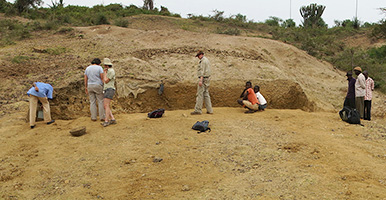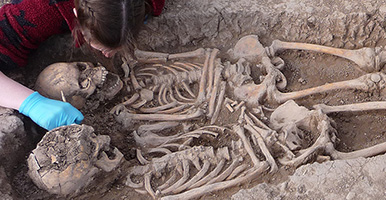Human variation and adaptability
Studying the patterns of variation in humans
We take an interdisciplinary approach to the study of human variation, both at genotypic and phenotypic levels, through the fields of palaeoanthropology, bioarchaeology, human palaeogenetics, evolutionary genetics and human biology.
Palaeoanthropology aims to understand the biology of hominins through morphological variation of the skeleton.
Bioarchaeology is focused on the link of human variation, cultural evolution and its interaction with the natural environment.
Human palaeogenetics studies DNA from archaeological contexts to explore the ancestry of human populations and the role of ancient migrations in shaping the current genetic pool and to provide information about social practices in the past.
To explain the patterns of variation in the human phenotype, we study the mechanisms of adaptability of humans among recent historic and living populations using human biology and genetics.
Impact case study: Telling the story of human evolution
Research areas and current projects
Palaeogenetics
We are interested in the study of the genetic variability of prehistoric populations as a means to understand patterns of prehistoric migrations and its role in shaping the cultural landscape of prehistoric Europe. We are also interested in animal domestication and the often complex patterns of genetic admixture that shaped the gene pool of ancient as well as modern farm animals.
We are currently working on several collaborative research projects, including prehistoric and early historic human remains from Britain and Scandinavia, as well as prehistoric remains of dogs and pigs from West Asia and Europe.
Facilities
Palaeogenetic analyses are conducted within the Low Copy Number (LCN) laboratories in the Life Sciences Building. These laboratories are built following the highest standards for ancient DNA work, including positive pressure, HEPA filters and UV light. The LCN laboratory is structured in three different suites:
- Sample preparation room equipped with a sandblaster, a freezer mill and a cross-linker
- DNA extraction room equipped with a laminar flow hood, cross-linkers, centrifuges, vortex, scales, fridge-freezers
- PCR-NGS library preparation room equipped with a laminar flow hood, centrifuge, vortex and thermal block
Post-PCR and post-Illumina library preparation are conducted in the molecular biology research laboratories equipped with a fume hood, thermocyclers, electrophoresis systems, centrifuges, scales, thermal blocks, water baths, Milli-Q system, Real-Time PCR system, nanodrop and several fridges and freezers.
Current collaborations
We actively collaborate with colleagues based at:
- Stockholm University
- Uppsala University
- Harvard University
- Liverpool University
- Oxford University
- Queen Mary University of London
Publications
Search publications written by members of this group:
Loading publications…
People
Meet the researchers within this theme:




